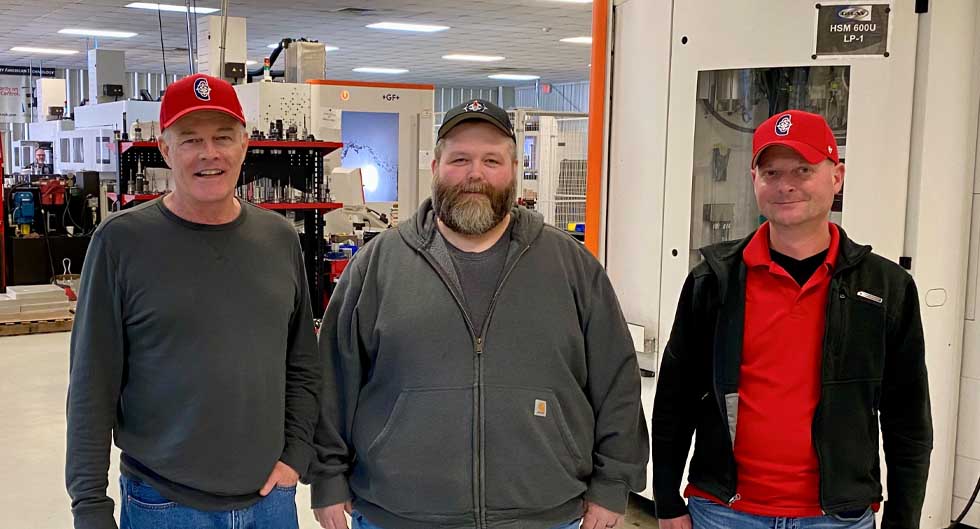Picking the Right Milling Orientation
Compass Precision added to its technical papers library last month with the release of a publication titled “When Is Horizontal CNC Milling Better Than Vertical Milling?” The authors are Justin Kovscek, Vice President & General Manager of Compass’s R&D Machine (shown on right in photo above) and Gary Holcomb, Compass CEO (shown on left above, with Compass’s Gray Manufacturing General Manager Evan Grose in middle).
To learn about this new technical paper, and why it is important, we recently caught up with Justin and Gary. Here is what they said.
Compass has written before about the virtues of horizontal milling. What’s different about this paper?
Gary – We wanted to specifically talk about the types of jobs best done on horizontal CNC mills versus their vertical cousins. Picking the most optimal machining center can make a huge difference, particularly for difficult parts.
Justin – My personal experience is that most shops lack a complete complement of different types of CNC machines. So, many of them do their best with the equipment they have. Unfortunately, the result is often suboptimal in terms of quality, delivery time, and cost. An MLB manager wouldn’t normally ask a first baseman to play shortstop, or a relief pitcher to catch. Picking the right CNC machine is no different.
Ok, what are some of the most important aspects of a milling job that influence whether to go horizontal?
Justin – Hahaha, it’s chip evacuation and we covered that at the very beginning of the paper. Horizontal milling greatly increases the chances that the metal chips created through milling will be flung away from the part’s surface and not interfere with subsequent machining.
Gary – As corny as it sounds, gravity is your friend when milling horizontally. With vertical milling, these chips sometimes accumulate on the surface of the workpiece, interfering with the tool paths and causing dimensional and surface quality problems.
Justin – In the past, when I have evaluated whether to use a horizontal mill or not, I have carefully considered whether the part in question has large flat surfaces or deep pockets where chips are likely to accumulate when milling vertically. Parts with these characteristics are probably best done on a horizontal machining center.
What else is important to consider?
Gary – As we discuss in the paper, horizontal mills are constructed in a fundamentally different way. The cheapest and easiest way to spin a spindle for milling is in a vertical orientation. This is why virtually every manual mill ever built is vertical. Horizontal mills are constructed in a much more robust way, which is why they are always more expensive.
Justin – But for that extra cost, you get a machine typically more capable of faster speeds and feeds. This means faster material removal without sacrificing surface quality or dimensional accuracy. So if there’s lots of material to remove versus the final part weight, horizontal machining is often the best choice.
Generally speaking, what type of part isn’t a good candidate for horizontal machining?
Gary – If a component fits well within a 36”x36”x30” machining envelope, doesn’t have deep pockets or areas where chips are likely to accumulate, and does not involve an unusual amount of material removal, then vertical milling is likely to work well.
Justin – A good rule of thumb to use on material removal is the initial-to-final part weight ratio. If this ratio is greater than 10-to-1, then a vast majority of the starting material must be removed to create the final part geometry. Parts like these are excellent candidates for horizontal milling because of the faster material removal rates possible with horizontal machining centers.
Finally, does Compass have an ample installed base of both horizontal and vertical machining centers?
Gary – We have a wide array of 3, 4, and 5-axis vertical mills as well as numerous horizonal machining centers. At Strom Manufacturing, our shop near Portland, OR, we have four horizontals including a brand new DMG Mori NHX 4000 purchased and installed in early 2023. This machine has 12 pallets and a lead-edge linear pallet conveying system capable of feeding this machine in support of extensive automation. Check out this cool video showcasing Strom’s lights-out operations.
Justin – We don’t currently have any horizontals at R&D Machine, but I have ready access to horizontal capacity at both Strom as well as at Quality Products, one of Compass’s shops in Charlotte that has two horizontal machining centers. My counterparts at other Compass operating companies and I routinely supply each other to take advantage of each shop’s differentiating capabilities. When you do business with a Compass operating company, you have access to eight shops, not just one.
For questions regarding this article or the technical paper it describes, please feel free to email Justin at [email protected] or Gary at [email protected]. For additional information about Compass, please contact VP of Sales Jim Miller at [email protected].


